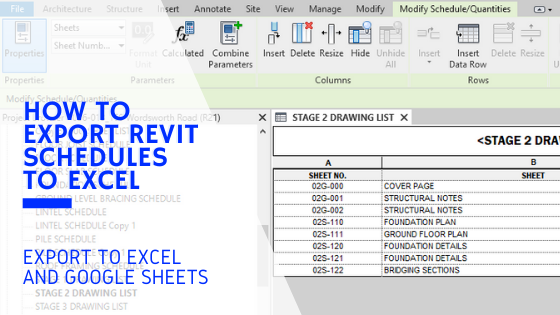Grasping the Art of Information Integration: Just How to Seamlessly Import Excel Data Into Revit
Are you struggling to import Excel documents into Revit efficiently? Look no further! In this post, we will certainly lead you through the process of grasping the art of information integration. Discover the value of smooth integration in Revit and explore the Excel data layout for Revit assimilation. Prepare yourself to prepare your Excel information easily and follow our detailed guide to import documents into Revit. With our best methods, you'll accomplish information assimilation success in no time. Let's start!
Recognizing the Value of Data Assimilation in Revit
Comprehending the value of information combination in Revit is crucial for seamless importing of Excel documents. When you incorporate data from Excel into Revit, it allows you to successfully upgrade and take care of information throughout the whole task. This combination guarantees that your design and building and construction procedure is precise and up-to-date.
By incorporating data, you can quickly import and update criteria, timetables, and even geometry in Revit. This eliminates the demand for hands-on data access, saving you time and reducing the threat of mistakes. With Revit's data assimilation abilities, you can maintain uniformity and accuracy in your task, while likewise improving cooperation among employee.

Exploring the Excel File Format for Revit Integration

In order to efficiently incorporate Excel files right into Revit, it is critical to make sure that the data is formatted appropriately. This consists of correctly labeling rows and columns, in addition to structuring the information in a method that is compatible with Revit's information schema. Revit utilizes details specifications and categories to arrange data, so it is very important to line up the Excel data with these criteria to guarantee a smooth combination.
In addition, it is necessary to note that Revit just supports specific data kinds when importing from Excel. These consist of text, numbers, and days. Any various other data kinds, such as formulas or conditional formatting, will certainly not be recognized by Revit and might cause problems during the combination process.
Preparing Your Excel Data for Seamless Import Into Revit
To ensure a smooth combination process, you'll need to effectively layout and label the columns and rows in your Excel data before importing it into Revit. Begin by examining your Excel data and determining which rows and columns consist of pertinent details for your Revit task.
Following, ensure that the data in each column is appropriately formatted. If you have a column for dimensions, make certain that all measurements are consistently formatted in the same units of dimension. Revit counts on regular format to properly analyze and import information.
In addition, it is vital to examine for any type of vacant cells or variances in your information. Revit may not have the ability to check out or import information from cells that are import excel into revit vacant or contain errors. Consequently, it is recommended to examine your Excel data and clean up any type of inconsistencies prior to importing it into Revit.
Step-By-Step Overview to Importing Excel Data Into Revit
Once you have actually appropriately formatted and classified your Excel data, you can quickly import it right into Revit by following this step-by-step overview. To start, open Revit and browse to the "Insert" tab. import excel into revit.
Next, a dialog box will show up, permitting you to customize the import setups. Here, you can select the worksheet you desire to import, specify the series of cells to import, and select the proper units for your data. As soon as you've made your choices, click "OK" to proceed.
Revit will now display a preview of your Excel information. Take a moment to make certain and evaluate the preview that whatever looks proper. If needed, you can make modifications to the import setups by clicking the "Setups" button.
Finest Practices for Information Assimilation Success in Revit
See to it you comply with these finest techniques to ensure successful combination of information in Revit. Most importantly, it is essential to arrange your information in Excel prior to importing it right into Revit. This indicates making certain regular naming conventions, proper formatting, and accurate data representation. Next, use Revit's built-in tools for data mapping. This will enable you to match the columns in your Excel data with the matching specifications in Revit. Be conscious of the systems and information types when mapping the data, as any discrepancies can result in errors in the integration process.
One more crucial practice is to routinely confirm and update your information. Furthermore, make use of information validation tools within Revit to recognize any kind of errors or incongruities in the integrated data.
Finally, it is recommended to develop a clear workflow for information combination. This includes specifying obligations and duties, establishing an interaction channel between group members, and developing a routine tempo for information updates and evaluations. By adhering to these best methods, you can make certain a effective and seamless combination of information in Revit, ultimately enhancing the performance and accuracy of your job.
Final Thought
To conclude, mastering the art of information assimilation is essential for seamless import of Excel submits right into Revit. Understanding the significance of information assimilation in Revit is the first step towards effective assimilation. Exploring the Excel file style for Revit combination aids in understanding the limitations and requirements. Preparing the Excel information correctly and adhering to a detailed guide is crucial for a smooth import process. By complying with best techniques, you can make certain data combination success in Revit and make one of the most out of your project.
When importing information from Excel into Revit, it is essential to comprehend the file format and how it can influence the assimilation procedure (revit add ins). Revit uses details criteria and classifications to organize data, so it is vital to straighten the Excel information with these parameters to ensure a smooth combination
Be mindful of the information and units kinds when mapping the information, as any type of discrepancies can lead to mistakes in the combination process.
In addition, make use of data recognition tools within Revit to recognize any type of errors or inconsistencies in the incorporated data.
